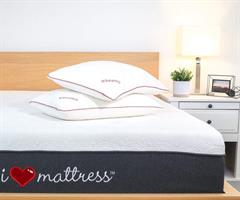Are snoring mouthpieces bad for teeth? The short answer is they can be.
This article will cover how these devices might affect your dental health, including tooth movement, jaw pain, and long-term oral issues. You’ll also learn ways to minimize these risks and explore alternative solutions.
Key Takeaways
-
Users of snoring mouthpieces may experience initial discomfort, dental side effects like tooth movement and jaw pain, and long-term impacts on oral health, necessitating regular dental check-ups.
-
Common side effects include tooth movement, jaw pain and TMJ issues, dry mouth, and changes in bite, which can result in gaps or misalignment of teeth.
-
Mitigating risks involves ensuring proper fit, routine maintenance of mouthpieces, and considering alternatives like positional therapy and CPAP for treating snoring and sleep apnea.
Initial Adjustment Period with Snoring Mouthpieces

The first few weeks of using a snoring mouthpiece can be challenging. Users often report initial discomfort as their mouths and jaws adjust to the new device. Common symptoms during this period include jaw soreness and dry mouth. These issues can make it difficult to stick with the treatment, but patience is key. Most users find that their bodies adapt to the device over time, usually within several nights to a few weeks.
During this adjustment phase, following the guidance of your dental sleep medicine specialist can be helpful. They can provide tips on easing discomfort and ensure that your device fits properly. Remember, this period is temporary, and the benefits of improved sleep and reduced snoring are well worth the initial inconvenience.
Common Dental Side Effects of Snoring Mouthpieces
While snoring mouthpieces can be highly effective in treating sleep disordered breathing, they can also lead to various dental side effects. These side effects can range from minor and temporary to more serious and long-lasting.
Anyone using or considering a snoring mouthpiece should be aware of these potential issues.
Tooth Movement
One of the most common side effects of using oral appliances is tooth movement. The constant force applied to the teeth during sleep can lead to gradual shifts in their positioning. Contrary to earlier beliefs, these movements can persist beyond the initial two years of treatment. Patients have reported various types of tooth movements, including upper teeth being retracted and lower teeth being pushed forward, which can affect overall bite alignment.
These changes in tooth alignment can result in gaps between the teeth and affect chewing efficiency. Long-term use of oral appliances increases the likelihood of these movements, emphasizing the need for regular dental check-ups to monitor and address any changes.
Jaw Pain and TMJ Issues
Jaw pain and temporomandibular joint (TMJ) issues are also common among users of snoring mouthpieces. Some individuals may experience temporary jaw pain when they start using the device. However, prolonged use can exacerbate temporomandibular disorder (TMJ). This can lead to significant discomfort and should be carefully monitored.
Managing these issues often requires regular dental check-ups. Dentists can adjust the device to alleviate pressure on the lower jaw and recommend exercises to strengthen the jaw muscles. Ignoring jaw pain can lead to more serious problems, so promptly addressing these symptoms is important.
Dry Mouth and Excess Salivation
Dry mouth is a frequent complaint among users of snoring mouthpieces, resulting from restricted saliva flow. This condition can lead to discomfort and complications such as difficulties in swallowing or speaking. On the flip side, many users report increased saliva production shortly after inserting the appliance.
This dual challenge highlights the complex adjustment process. Dry mouth can be uncomfortable, but excess salivation can be equally bothersome. Over time, most users find a balance, but it’s important to stay hydrated and consult with your dentist if these issues persist.
Long-Term Effects on Oral Health

Beyond the initial adjustment period, long-term use of snoring mouthpieces can have significant effects on oral health. These devices, while effective in treating snoring and sleep apnea symptoms, can lead to changes in dental alignment, bite, and overall oral health.
Minimizing these adverse effects requires regular monitoring and proactive management.
Bite Changes
Continuous use of snoring mouthpieces may result in noticeable shifts in dental alignment, potentially necessitating orthodontic treatment. Research indicates that consistent use of dental sleep appliances, including mandibular advancement devices, can change the bite for a significant percentage of users, often due to the anterior positioning of the mandible. These bite changes can create gaps in teeth and other alignment issues.
These changes can lead to significant skeletal and dental modifications, sometimes needing professional intervention to correct. Users might notice a slight change in their bite after removing the appliance, which underscores the importance of regular dental check-ups to monitor these shifts.
Tooth Wear and Damage
Prolonged contact with mouthpieces can lead to tooth wear and damage. This is particularly true for tongue-retaining devices, which often contribute to significant dryness in the mouth. Mucosal dryness can lead to discomfort and increase the risk of tooth erosion over time.
Being vigilant about long-term tooth wear and considering regular dental check-ups can help monitor oral health. Proper maintenance and periodic professional evaluations can help mitigate these risks.
Mitigating the Risks

Minimizing the risks associated with using snoring mouth guard pieces involves following best practices for maintenance, customization, and regular dental check-ups.
These steps can help ensure the dental devices’ effectiveness while safeguarding your dental health.
Regular Dental Check-Ups
Regular dental visits help patients using oral appliances monitor side effects and ensure appropriate treatment adjustments. Consulting a dentist regularly allows patients to modify their treatment plan based on any adverse effects encountered.
Patients should discuss any issues with their oral appliance with their sleep apnea dentist. Timely interventions can stop minor issues from becoming significant problems.
Proper Fit and Customization
Custom-fitted anti-snoring mouth guards provide a precise fit, greater comfort, better effectiveness, and typically last longer. To obtain a custom mouthpiece, ask your dentist about their experience with sleep-related disorders.
Generic over-the-counter mouthguards achieve a fit through a boil-and-bite process, where the mouthguard is softened in hot water and then molded using bites. While these can be a budget-friendly option, they may not provide the same level of comfort or effectiveness as custom devices.
Maintenance and Cleaning
Maintaining and cleaning snoring mouthpieces properly is vital for oral health. Regular maintenance and cleaning of oral appliances prevent bacteria accumulation and maintain overall oral health.
Neglecting mouthpiece maintenance and cleaning can lead to bacterial build-up, potentially causing oral health issues. Following specific cleaning protocols and regularly checking the mouthpiece’s condition ensures its effectiveness and hygiene.
Alternatives to Snoring Mouthpieces

Several alternatives to anti snoring mouthpieces are available to help treat snoring and obstructive sleep apnea, including sleep apnea treatment and an anti snoring device.
These alternatives range from positional therapy to CPAP therapy and lifestyle changes.
Positional Therapy
Positional training with a tennis ball or specialized pillows can effectively maintain a lateral sleep position. A body pillow can support side sleeping, making it easier to maintain this position throughout the night for a restful night’s sleep.
Taping tennis balls to the back of pajamas can discourage back sleeping, which is often linked to snoring. Positional therapy reduces snoring by encouraging specific sleep positions.
CPAP Therapy
Continuous Positive Airway Pressure (CPAP) therapy is the gold standard for treating obstructive sleep apnea. CPAP machines effectively treat sleep apnea by maintaining open airways, though the mask and noise can be uncomfortable for many users.
CPAP equipment can be uncomfortable and may require adjustment to ensure proper fit. Despite these challenges, CPAP therapy remains highly effective for those with obstructive sleep apnea.
Lifestyle Changes
Weight loss significantly reduces snoring in individuals who are overweight. Lifestyle adjustments like losing weight and avoiding alcohol before bedtime can significantly reduce snoring and improve overall sleep quality.
Maintaining a healthy weight can minimize snoring, especially if weight gain has been a contributing factor. Reducing alcohol consumption before bedtime lowers the chances of snoring by decreasing muscle tone in the throat.
Summary
In summary, while snoring mouthpieces can be effective in treating snoring and sleep apnea symptoms, they come with potential side effects that users should be aware of. From initial discomfort to long-term dental changes, understanding these risks is crucial for maintaining oral health.
By following best practices, such as regular dental check-ups, ensuring proper fit and customization, and maintaining and cleaning the device, users can mitigate these risks. Exploring alternative treatments, like positional therapy, CPAP therapy, and lifestyle changes, can also provide effective solutions for snoring and obstructive sleep apnea. Stay informed and proactive in managing your sleep health for the best outcomes.
Frequently Asked Questions
What are the common side effects of using a snoring mouthpiece?
Using a snoring mouthpiece can lead to side effects such as dry mouth, jaw soreness, and tooth movement. It’s important to monitor these effects and consult a professional if they persist.
How long does it take to adjust to a snoring mouthpiece?
Adjusting to a snoring mouthpiece usually takes several nights to a few weeks, and it's common to experience some initial discomfort during this period.
Can using a snoring mouthpiece cause permanent dental changes?
Yes, prolonged use of a snoring mouthpiece can lead to permanent dental changes and misalignment, potentially requiring orthodontic intervention.
How can I mitigate the risks associated with using a snoring mouthpiece?
To mitigate the risks associated with using a snoring mouthpiece, ensure a proper fit, maintain and clean the device regularly, and schedule regular dental check-ups. This proactive approach will help you use the mouthpiece safely and effectively.
Are there alternatives to using a snoring mouthpiece?
Yes, alternatives to a snoring mouthpiece include positional therapy, CPAP therapy, and making lifestyle changes like weight loss and minimizing alcohol consumption before bedtime. These options can effectively help reduce snoring.


